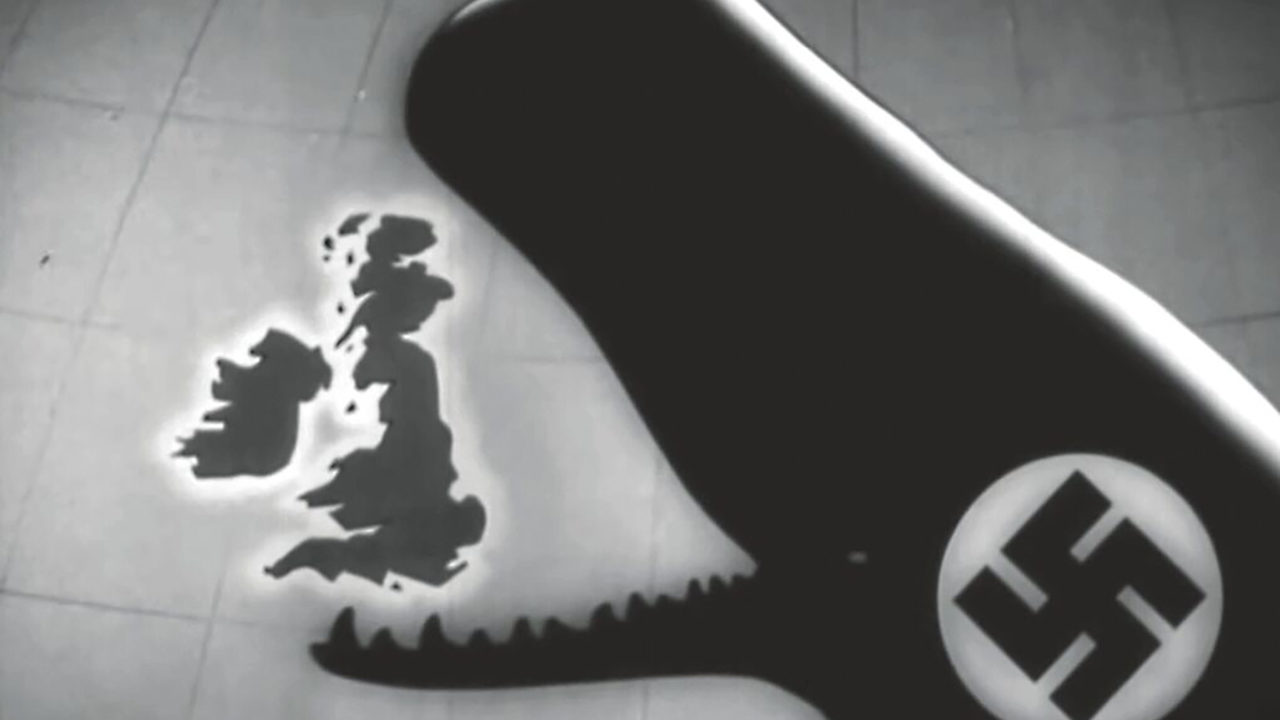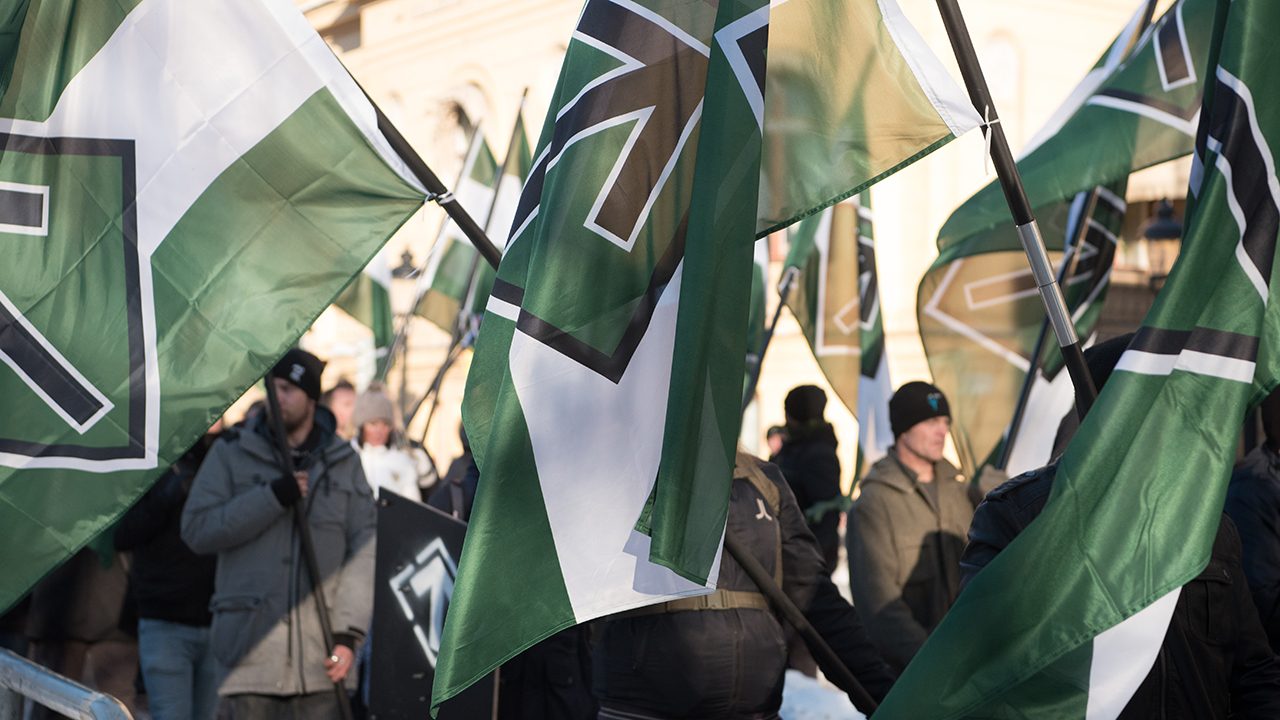
It’s February 25th, 2023, a cold and snowy day in Berlin at Brandenburger Tor. Around 15,000 protestors have gathered at the iconic monument that represents, like no other building in Berlin, the political conflicts of the Cold War. The left-wing populist Sahra Wagenknecht and the feminist icon Alice Schwarzer had called for a demonstration to end the war. They call for an end of aiding Ukraine with weapons and demand peace talks.
Among the speakers is Erich Vad, former military advisor to Chancellor Angela Merkel. Vad claims that the war is entering a new phase, drawing analogies to the First World War and the uncountable suffering. But Vad is not only a highly decorated army general. He is also the author of an essay that was published in the far-right magazine Sezession in 2003, in which he explores the contemporary relevance of Carl Schmitt’s political and legal theory. The constellation seems odd at first sight. But digging into the relevance of Schmitt’s thinking for illiberal actors, can help us to understand, what found common ground in Berlin.
When liberal democracy is in crisis, anti-liberal resentments flourish. According to these, the political system is merely a facade, “the people” have allegedly lost their sovereignty, and citizens are merely consumers in a political show. It’s not only conservatives and far-right extremists who put forward cultural pessimist sentiments, lament a supposed decline in values and a sellout of society. There is also a long-standing tradition of anti-parliamentary resentment on the left, traceable back to early socialist thinkers in the 19th century, seeking the root of all evil in liberal democracy and longing for “true democracy”, seemingly free of contradictions.
This overlap is clearly illustrated by the persistent popularity of the former constitutional lawyer Carl Schmitt (1888-1985) across the board. Schmitt was an opponent of Weimar parliamentarism, a proponent of the so-called “conservative revolution” in the years up to 1933. Thereafter, he was a supporter of the Nazi regime in various capacities. And yet, he remains probably “the most discussed German legal expert of the 20th century”, as historian Raphael Gross surmised in his work on Schmitt’s antisemitism, Carl Schmitt and the Jews. Time and again, left-wing and liberal analyses emphasize that Schmitt’s work could help to explain the current state of crisis in liberal democracy: He “clearly marked the gateways for the opponents of liberal democracy in his constitutional theory and in his analysis of the Weimar crisis”, states the political scientist Jens Hacke, for example. Widely received leftist philosophers such as Giorgio Agamben or theories as
Chantal Mouffe’s conception of a left populism refer to the potential to discuss Schmitt progressively. Not surprisingly, a surge in the reception of Carl Schmitt in Communist China has recently been observed.
But what assumptions underlie Schmitt’s anti-liberal resentment? Based on the works of critical theorists such as Theodor W. Adorno and Franz L. Neumann, we can show that Schmitt’s thinking cannot be separated from his antisemitism and that he remains an ideological expression of negativity deeply rooted in contemporary society. This can best be shown regarding Schmitt’s notion of the political, which he derives from the irreconcilable friend-foe antagonism, and in his associated notion of illiberal democracy – aspects that are put forward in appropriations of Schmitt across the political aisle.
Identitarian Democracy
In his now 100-year-old essay from 1923, The Crisis of Parliamentary Democracy (Die geistesgeschichtliche Lage des heutigen Parlamentarismus), Schmitt resents proletarian masses entering the state apparatus of the Weimar Republic through socialist political parties. According to him, the transformation from bourgeois to mass democracy fundamentally altered the character of parliament: away from an alleged liberal “government by discussion”, in which men convinced each other based on rational arguments, to a “government by bargaining” between pluralistic interest-groups, in which political decisions were shrivelled to a matter of haggling and compromise.
His idealization of parliament as a place of enlightened discussion – an ideal that was never realized – and his cultural pessimistic resentment regarding modern parliamentarism rely on a specific notion of democracy. It goes back to Schmitt’s discussion of the philosopher Jean-Jacques Rousseau and his Contrat Social. In it, Schmitt refers to Rousseau’s idea of popular sovereignty (Volkssouveränität), which essentially consists of the identity of rulers and ruled. According to Rousseau’s conception, the “volonté de tous” was merely a sum of egoistic interests and stood in juxtaposition to the ethical notion of a “volonté générale”. He regarded the former as an expression of a society divided into different interest groups, which he perceived as poison for democracy. The “volonté générale”, on the other hand, was based on a homogeneous people, culturally, socially or economically.
The Schmitt-critic, legal scholar and political scientist Franz L. Neumann (1900-1954) pointed out in his posthumously published essay Intellectual and Political Freedom from 1955 that Rousseau had the fraternal democracy of Sparta in mind when conceptualizing his democratic theory. Neumann, who had fled Nazi-Germany as early as 1933, outlined his essay as professor of political science at the Columbia University in New York, whilst playing a major role in developing political science as a democratic discipline in post-Nazi Germany. According to Neumann, Schmitt incorporated the idea of a warlike military community into his critique of Weimar parliamentarism. Not surprisingly, Schmitt understood the crisis of democracy in the mid-1920s as being accompanied by a “general feminization” of society after the introduction of the general right to vote, through which also women were integrated into the democratic system of Germany.
Based on his selective reading of Rousseau’s philosophy, Schmitt considered the idea of relatively independent parliamentary representatives and the division of powers to be incompatible with democracy. These were, according to him, liberal rather than democratic principles. He even claimed them to be contradictory to democracy and sought to “save democracy” from itself, as Neumann states in his analysis of National-Socialist rule in 1942. Conversely, this meant that the volonté générale – “the homogeneous will of the people” – had to embody both the legislative and executive power. That is why, for Schmitt, democracy didn’t contradict forms of dictatorship. According to him, the will of the people could even be better expressed when in the hands of one leader than in “the statistical apparatus” of parliamentary democracy. In this sense, his political theory provided a justification for the transformation of the rule of law into the rule by force, as Neumann criticized Schmitt in his best-known book Behemoth.
Discomfort with democracy
Ideas of the “true will of the people“ in contrast to a “corrupt liberal elite” and its alleged political intrigues are widely popular today in populist movements across the globe. Schmitt put forward a common resentment against the two-fold character of modern democracy, in which political rule and the people aren’t identical. Rather, democratic rule in its modern form is “a government of laws and not of men”, as John Adams, one of the founders of the U.S. Constitution, famously put it. But at the same time, according to Neumann, power is exercised by social actors and opposing, competing and unequal interest groups (e.g. trade unions, industrial associations, environmental protection organizations, energy companies, feminist or queer initiatives or religious groups).
Modern democracy must be thought of in terms of this specific two-fold character as it was conceived of by Neumann: Formally, there is freedom and equality through the rule of the general laws. But on the social level, there is a struggle between competing rackets, as can be stated based on the social theory of Theodor W. Adorno and Max Horkheimer. Neumann, who had attended a seminar with Schmitt in the late 1920s, analysed the antagonism between the struggle of interest groups on the one hand and the liberal rule of formal freedom and equality as the dialectic of democracy between force and law that forms the basis of modern domination. It manifests itself institutionally in the division of powers, of which the legislative and executive branches represent the dialectical poles and the judiciary mediates between the two.
Schmitt’s resentment against the ambivalence of modern democracy led him to fight liberalism as a whole, and with it, the formal freedom and equality it promotes. He contrasted real existing democracies with a pure ideal of “true democracy”, leading to reality ever failing to live up to this comparison. Schmitt thus ideologically represents a discomfort with modern democracy, that is rooted in this core antagonism of modern societies. The discomfort can, especially in times of crises, lead to a radicalization, to a kind of ideological false healing, as in ethnic-nationalist ideas: The fantasy of an omnipotence of the executive, which is supposed to be ultimately realized in the (ethnically) homogeneous people through the identity of rulers and ruled. At its core stands the fantasy of “healing” the discomfort by eradicating the contradiction between force and law, leading to the naked rule of force. For this purpose, Schmitt puts forward his notorious friend-enemy opposition, which fundamentally shapes his writing.
The Enemy, the split object
One of Schmitt’s best-known claims is that democracy “necessarily involves, firstly, homogeneity and, secondly – if necessary – the elimination or annihilation of the heterogeneous”. For the conception of such identity, “the heterogeneous”, “the other”, “the enemy”, which refer to the same entity in Schmitt’s thinking, is to be fended off. The determination of the enemy is constitutive for the state as a “political association”, as he writes: “If it were to renounce the possibility of deciding whom it considers and treats as an enemy”, it would, according to Schmitt, “not be a political entity”.
This thought is based on abstract negation because it strives to obliterate contradictions. They are erased by setting the other as a mere negative image of the self through splitting and projection, and thus by construction of a friend-foe opposition. How “the other” is experienced and that it appears as an enemy at all has thus little to do with the actual other, it serves only as a construction of one’s own identity. It thus becomes something “existentially other and alien”, as Schmitt puts it, because the very existence of the other reminds one of one’s own “prehistory”, of the violence out of which our own identity in modern capitalist and patriarchal societies is carved, and of its artificiality. The threat stemming from this memory must be warded off.
For Schmitt’s concept of the political, it therefore doesn’t suffice that the enemy is clearly distinguished from the friend. Rather, it requires a “real struggle against a real enemy”. Thus, for Schmitt, the warlike designation of the enemy is decisive for one’s identity. In the most extreme case, this includes the annihilation of the enemy. The means for this are legitimised by the violence that was previously necessary to separate “the other” from oneself in the first place. And so, it is hardly surprising that in Schmitt’s theory the friend-enemy distinction culminates in struggle, in war and civil war. This struggle is both the starting point and the vanishing point of Schmitt’s thought, and is directly linked to his antisemitism. An antisemitism that, as Gross worked out, was not only formative after 1933, but already before.
Antisemitism and the fear of the non-identical
Friend and enemy form two sides of the same coin. “Feminisation”, proletarian masses, or “alien peoples” are strangers and, if need be, enemies in his elitist, fraternal theory. But they do not become “absolute enemies”. This role is reserved for “the Jews”, towards whom Schmitt’s paranoid fear and the threat of annihilation is directed in the last instance. Jews, in his antisemitic fantasy, are in this respect not merely “others”, as antisemitism is still often misunderstood today. “The Jew” is for Schmitt “the archetype of the enemy”, as Gross reconstructs. It is this structure of thought that anchors Schmitt deeply in the Manichean thinking of Christian and national antisemitism.
In his antisemitic imagination, Jews are “the third”, as the sociologist Klaus Holz has reconstructed regarding national antisemitism. In the antisemitic mind, Jews represent the non-identical, that which doesn’t fit into the division of friend and foe, into the national or religious order. It is neither I nor the enemy, neither one’s own nation nor the enemy nation. It is not only the result of projection, but of pathic projection, as can be argued with Adorno’s and Horkheimer’s theses on antisemitism in the Dialectic of Enlightenment. The non-identical is therefore, unlike “the other”, “the stranger”, not tangible as an object. The fantasised power that emanates from it seems invisible and thus at the same time omnipresent to the paranoid mind. The non-identical appears as impotent because it seemingly avoids the fight, and omnipotent at the same time because it can allegedly afford to leave the all-encompassing existential struggle Schmitt has in mind.
Accordingly, the violence with which identity is established produces not only “the other”. By stroke of the same violence, it brings forth the non-identical. The non-identical admonishes the violence and threatens to turn against the self. The constant reminder of this violence weighs on the conscience as a feeling of guilt and aggression. Schmitt ascribes the guilt to “the Jews”, especially assimilated or converted Jews, whom he found particularly threatening. “The Jew” haunted Schmitt “as a – his – subject and as a metaphysical enemy against which he fought for the rest of his life.”
After the military defeat of Nazism, Schmitt was arrested and interned in 1946 for his support of the National Socialist regime. He perceived this as a great injustice: “There is less justice today than under the Nazis”, he wrote, referring to his one-year imprisonment under the Allies. He developed a fear of Jewish revenge that was as justified as it was paranoid, as Schmitt biographer Reinhard Mehring writes. “What the Nazis did was brutal, what is happening to me (and thousands of honest Germans) is diabolical”, Schmitt noted. “The inability to admit one’s own guilt led to a hardening of the anti-Jewish affect”, Gross explains this specific form of antisemitism: the rejection of the feeling of guilt and the accompanying reversal of perpetrator and victim.
This specificity of antisemitism shaped large parts of German society after 1945, especially in the conservative and nationalist segments. But it could also be observed in parts of the political left from the late 1960s in the form of anti-Zionism, “whose antisemitic bias” as a form of relief of guilt became apparent from then on, as Jens Bennicke points out in his book From Adorno to Mao.
False friends
Here, too, Schmitt’s thinking offers a link. His eclectic thinking made his work compatible with a culturally pessimistic materialism of leftist provenance. In his theory, even “a ‘class’ in the Marxist sense of the word … can become a political entity if it takes the class ‘struggle’ seriously and treats the opponent as a real enemy and fights him …”, as Schmitt had already formulated in his contribution The Concept of the Political of 1932. In particular, the irreconcilability with which Schmitt pits friends and enemies against each other, domestically to the point of civil war or in foreign relations to the point of war, repeatedly serves as a model of uncompromising political struggle.
It is what makes Schmitt attractive for seemingly radical positions. Accordingly, there are attempts from the left to invalidate Schmitt’s völkisch punch line: There, the notion of “Volk” is not thought of as a natural or essentialist entity, but as a social construction. This appropriation of the friend-foe definition for leftist theories, however, shares with Schmitt the tendency to falsely ‘heal’ the discomfort with the two-fold character of modern democracy. Thus, not even left appropriations can get rid of Schmitt’s enmity directed at heterogeneity.
Other than in Schmitt’s thinking, however, the discomfort on the left is not resolved in ethnic homogeneity but in a socio-economic “true democracy”, conceived of either as a “direct” or “radical” democracy in anarchist or anarcho-communist thinking or the “dictatorship of the proletariat” in Marxism-Leninism. This partially explains left-wing interest in Schmitt’s Theory of the Partisan from 1963, for example in the case of the former Maoist Joachim Schickel. His conversations with Schmitt about the communist revolution in China and the role of guerrilla fighters in the anti-imperialist national liberation movements popularized Schmitt’s thinking among sections of the left and leads until today to obscure alliances, in which Putin’s Russia appears as a potential ally against “western imperialism”. This can also help to explain the popularity of Schmitt’s thinking in contemporary political thinking in Russia, as it is put forward by Aleksandr Dugin, Putin’s ideological arms-bearer.
Schmitt’s theory of fending off paranoid anxiety by splitting and externalizing negative aspects of the “own” and projecting it on “the other”, simultaneously bringing forth the non-identical, is highly attractive in social, economic or political crises. Especially in times when apocalyptic fantasies are widespread, it is not surprising that Schmitt’s theory is becoming more popularly received, as political scientist Quinta Jurecic noted. The ideological longings for overcoming antagonisms and paranoid fear are increasing rather than decreasing.
Untruth of Schmittism
Schmitt’s antisemitism cannot be detached from his theory. Rather, it represents a cornerstone in his concept of the political, in his friend-foe antagonism. His antisemitic anxiety accompanied him throughout his life. This remains evident as late as 1975, when he notes “Under the eyes of the Jews” in his personal papers under a stamp with a portrait of the Jewish feminist writer Else Lasker-Schüler. He remains paranoid, finding himself persecuted by “the Jews”.
Based on Neumann’s theory of law and democracy, we can unravel that Schmitt, with his antisemitic resentment against the rule of general law and against the separation of powers, dissolves the dialectic of force and law to the side of force. He takes the historical division of people into nations and collectives and turns it into a natural law, which he mobilises against liberalism. Thus, according to Neumann, he becomes an advocate of force and the mythological, which are negatively incorporated into the enlightenment.
What found common ground in Berlin at the peace demonstration on February 25th was nothing less than the authoritarian mobilisation of mythology against universalism and the rule of law. Other than promoting peace, the protestors and speakers promoted a peace dictated by the rule of naked violence on the battlefield. It shows that parts of the left remain in a dangerous tradition of anti-liberalism and don’t hesitate to seek alliances with the far right. But it is not only the far left and the far right that can be mobilised. In Germany, there is a long-standing tradition of discussing Schmitt’s theory from a liberal perspective, as the former German Federal Constitutional Court judge Ernst-Wolfgang Böckenförde tried to do.
But Schmitt’s polemic against liberalism is, to conclude with Adorno, only the “half-truth” and as such “the whole untruth”. That is why Schmitt must be fundamentally criticised, in that those promises of force, mythology, and identity are themselves understood as dialectical moments of modern society. To do so, we need a critical theory of society, for “freedom would be not to choose between black and white, but to step out of such prescribed choice”, as Adorno emphasises in Minima Moralia regarding Schmitt’s identity thinking.
This essay was originally published in German in the newspaper “nd”.


